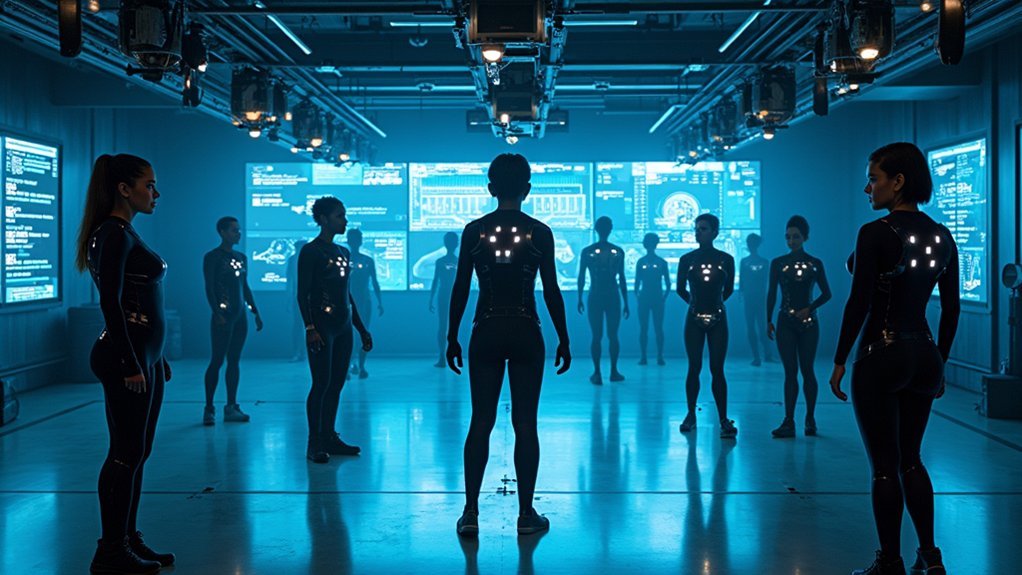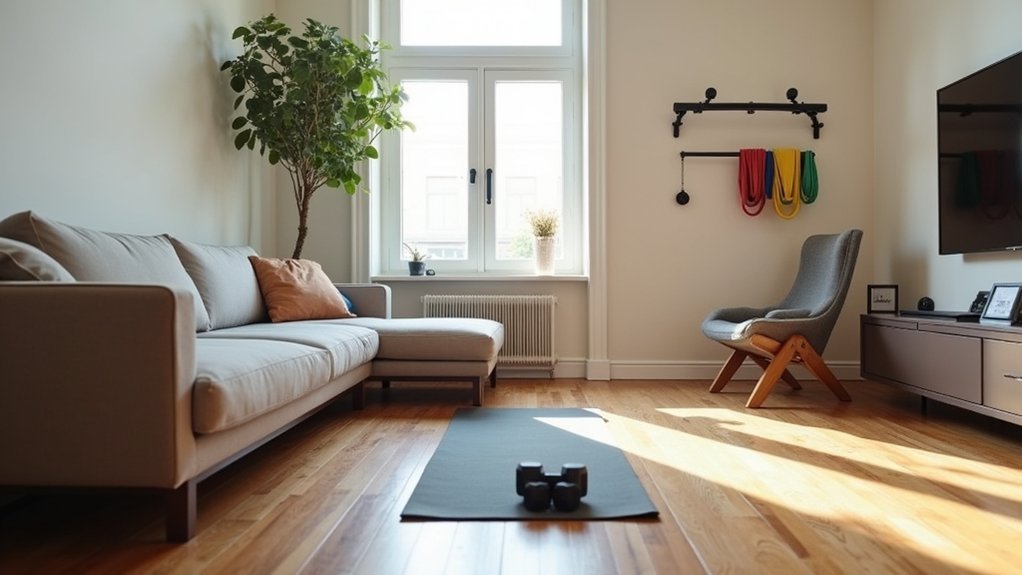To set up multi-user tracking solutions, designate individual 2m × 2m play areas with non-overlapping zones to prevent collisions. Position base stations at 6-7 feet high, angled toward the center for ideal coverage. Choose between inside-out camera systems for portability or outside-in beacon systems for precision. Implement sensor fusion combining optical tracking with IMU data for improved accuracy. Guarantee each headset has dedicated USB 3.0 connectivity and sufficient processing power. The following guide will unpack each critical step for seamless multi-user experiences.
Understanding Multi-User VR Tracking Requirements
When designing a multi-user VR tracking solution, you’ll need to address several critical requirements to guarantee smooth operation. Start by planning individual play areas of approximately 2m × 2m per user, ensuring these zones don’t overlap to prevent collisions and tracking interference.
Your tracking environment should leverage sensor fusion, combining optical tracking with high-frequency IMU data (800Hz) to improve accuracy and reduce latency. Position cameras strategically around the perimeter to eliminate blind spots, and account for a 1.5m border beyond camera detection range.
Fuse optical tracking with 800Hz IMU data while eliminating perimeter blind spots for precision multi-user VR experiences.
Hardware considerations are equally important—each headset requires dedicated USB 3.0 connectivity and must support 4K resolution at 90 FPS.
For wireless setups, pay careful attention to signal reliability to prevent tracking interruptions during multi-user sessions. Consider installing Teamviewer with appropriate VPN settings to enable remote connections for distributed multi-user eye tracking experiments.
Selecting the Right Hardware for Simultaneous User Tracking
When choosing hardware for multi-user VR tracking, you’ll need to decide between inside-out camera systems that offer portability and outside-in beacon systems that provide higher precision.
Your hardware must scale effectively with user count, considering tracker-to-dongle ratios and potential USB port limitations that occur when tracking multiple participants simultaneously.
While outside-in solutions deliver superior accuracy for professional applications, they come at a considerably higher cost per user compared to more affordable inside-out options that might suffice for casual multi-user experiences. For optimal performance in multi-user setups, ensure you have adequate lighting conditions since self-tracking trackers rely on Computer Vision technology combined with IMU sensors.
Cameras vs. Beacon Systems
Two primary technologies dominate the multi-user tracking landscape: camera systems and beacon networks. When choosing between them, consider how each technology aligns with your specific tracking needs and environment.
- Coverage and Accuracy: Cameras provide wide-area coverage ideal for open spaces, while beacons excel at precise indoor tracking where GPS fails.
- Implementation Requirements: Camera systems need more complex infrastructure but capture rich visual data; beacons require less installation but need user apps to function. Many retailers leverage camera systems to track customer counts entering their stores while gathering valuable conversion data.
- Cost Considerations: Beacons typically cost less initially, but cameras may offer better long-term value for large-scale tracking.
- Data Collection: Cameras capture extensive visual behavior data, whereas beacons focus on location-specific interactions and proximity data.
For best results, consider combining both technologies to leverage their complementary strengths.
Hardware Scalability Requirements
Selecting the right hardware forms the foundation of any successful multi-user tracking solution, especially as your system scales to accommodate more simultaneous users. Your processor should be at minimum dual-core, with four or more cores recommended for high-density environments. Each additional user requires approximately 2 cores and 4 GB RAM for peak performance. A minimum of 100 Mbps connectivity is required for effective network performance throughout the installation.
| User Count | Recommended Specs | Cost Considerations |
|---|---|---|
| 1-5 users | 4 cores, 8GB RAM | Entry-level servers |
| 6-15 users | 8 cores, 16GB RAM | Mid-range hardware |
| 16-30 users | 16 cores, 32GB RAM | Enterprise grade |
| 30+ users | Multiple servers | Load balancing |
| Future growth | +25% capacity | Upgrade planning |
Remember to install software individually on each machine for tailored configurations. Regularly monitor system performance using tools like Task Manager to identify enhancement opportunities.
Precision vs. Cost
Beyond raw processing power, the balance between precision and cost represents a fundamental decision point when building multi-user tracking solutions.
You’ll need to evaluate your specific requirements against your budget constraints to find the ideal hardware configuration.
- Device precision tiers – Basic GPS trackers offer real-time tracking at lower costs, while advanced models with geofencing and SOS alerts command premium prices. Consider devices like the Bad Elf GPS Pro+ that offer excellent accuracy while remaining budget-friendly compared to professional-grade equipment.
- Ongoing expenses – Factor in subscription fees, battery replacements, and software updates when calculating total ownership costs.
- Feature necessity – Determine which capabilities are essential (real-time tracking) versus optional (activity monitoring) for your specific use case.
- Scalability impact – Higher precision devices typically cost more per unit, directly affecting your ability to scale tracking across multiple users.
Setting Up Base Stations and Spatial Anchors
You’ll need to position base stations at heights of 6-7 feet and within 23 feet of your play area, ensuring they’re angled toward the center of your tracking space for ideal coverage.
When calibrating spatial anchors, align them with prominent environmental features and maintain clear line-of-sight to all base stations to establish reliable reference points. For optimal performance, utilize the full 150-degree field of view of each base station by adjusting their angles appropriately.
Run the calibration procedure for each anchor point individually, then verify multi-user tracking by having each user enter the space one at a time while confirming consistent positional data.
Positioning Hardware Setup
Proper installation of positioning hardware forms the foundation of any reliable multi-user tracking system.
You’ll need to strategically place base stations and spatial anchors to guarantee accurate tracking across all users in your virtual environment.
- Mount base stations at opposite corners of your space, angled downward at 30-45 degrees to maximize coverage area while minimizing occlusion zones.
- Position spatial anchors throughout the environment at varying heights, ensuring they’re visible to multiple tracking sensors simultaneously.
- Minimize interference by keeping base stations away from reflective surfaces, direct sunlight, and equipment that emits infrared signals. This approach helps create more accurate deterministic tracking similar to how cross-device solutions identify users across multiple devices.
- Test coverage thoroughly by having users move throughout the entire tracking area while monitoring for dead zones or tracking inconsistencies.
Anchor Calibration Techniques
Once hardware placement is complete, calibrating your anchor system becomes the next technical hurdle to overcome. Start by implementing autocalibration algorithms that use tracking data alone, making it easier to extend your system later.
You’ll need to utilize multilateration techniques requiring at least three anchor-tag distance measurements for accurate positioning.
For complex environments, consider Gaussian Process methods combined with CT-LIO for large-scale UWB systems. In industrial settings like seaports and warehouses, positioning accuracy is significantly affected by non-line-of-sight issues that require specialized calibration approaches. When dealing with multiple cameras, guarantee 3D spatial consistency and implement cross-camera reidentification using anchor-guided clustering.
To maximize accuracy, focus on NLOS mitigation by strategically distributing anchors to minimize non-line-of-sight scenarios. Implement multi-path mitigation techniques like beamforming to reduce interference.
For best results, evaluate your calibration using both synthetic data and real-world performance metrics like IDF1 scores.
Configuring Motion Capture Systems for Multiple VR Users

While single-user VR setups can be relatively straightforward, configuring motion capture systems for multiple users requires careful planning and implementation.
Multi-user VR motion capture demands meticulous preparation where single-user systems might allow simplicity.
You’ll need to select hardware that scales with your needs, whether optical tracking cameras like OptiTrack or wearable sensor systems that combine inertial and optical tracking.
- Define your physical tracking area and map it to virtual space, using calibration protocols to align real and virtual environments for all users. Many professionals prefer using Valve Index or HTC Vive headsets for the most accurate tracking results in multi-user setups.
- Select tracking hardware that supports your user count, considering wireless solutions to reduce clutter and enable free movement.
- Connect motion capture data to your game engine, establishing player IDs and mapping body parts to virtual avatars.
- Optimize for low latency (<10ms) and synchronize all devices to guarantee smooth real-time interaction.
Synchronizing Data Across Multiple Headsets and Controllers
After establishing your multi-user VR tracking environment, you’ll face the challenge of synchronizing data across all connected devices. Implement timestamping techniques to align device clocks and reduce latency between headsets and controllers. For advanced synchronization needs, consider adopting NVIDIA’s specialized Cross-Process Synchronization API which guarantees correct GPU timeline coordination without performance overhead.
| Synchronization Method | Key Benefit |
|---|---|
| Time Stamping | Reduces data mismatch between devices |
| Audio-Based Sync | Achieves alignment within 10ms using inaudible markers |
| Data Integration APIs | Provides unified access to positional and state data |
| Cross-Process Solutions | Enhances frame coherence across multiple systems |
Utilize SDK frameworks that support retrieving multiple devices’ data synchronously. Consider implementing audio-based synchronization like MIT’s Ekho system for resilient alignment without heavy computational requirements. For peak performance, compensate for clock frequency offsets between devices by scaling timestamps, which prevents drift and maintains consistent tracking information across your multi-user VR setup.
Calibrating Tracking Accuracy in Shared Virtual Spaces
Accurate calibration of tracking systems serves as the backbone of any successful multi-user VR experience. When multiple users share a virtual space, even small tracking discrepancies can disrupt collaboration and immersion.
To guarantee precise tracking across devices:
- Establish a reference grid framework for measuring positional and rotational errors (typical fingertip error: ~1.1cm for markerless tracking).
- Measure and verify tracking delays between input and display (average delay: ~45ms for optical hand-tracking).
- Assess finger joint accuracy separately for each joint type (Meta Quest 2 averages 9.6° joint angle error).
- Implement continuous calibration with error thresholds that trigger automatic recalibration.
Choose appropriate calibration targets based on your specific use case—cylinder-type targets offer the most stable tracking (mean error: 10.7mm with HoloLens 2). OptiTrack systems can support tracking hundreds of users simultaneously across areas as large as 100′ × 100′ with their active LED markers.
Troubleshooting Common Multi-User Tracking Challenges
Despite careful setup, multi-user tracking systems inevitably encounter obstacles that can disrupt your virtual experiences. When facing data silos, implement iPaaS solutions to unify your disparate systems or choose all-in-one platforms with native integrations from the start.
Identity resolution issues often surface when users don’t consistently log in across devices. Counter this by deploying advanced identity graphs that probabilistically link user actions.
For privacy compliance challenges, balance robust consent mechanisms with user-friendly experiences to minimize opt-out rates.
Technical constraints like poor connectivity or GPS inaccuracies can undermine tracking reliability. Implement multi-satellite technology and guarantee your tracking solutions offer thorough APIs for seamless integration with existing systems. Regular data audits ensure your tracking information remains accurate and reliable over time.
When troubleshooting time zone discrepancies, standardize timestamp formats to align cross-source data during consolidation.
Optimizing Performance for Large-Scale VR Experiences
Building on our troubleshooting knowledge, performance optimization becomes the next frontier for successful multi-user VR experiences. When multiple users share the same virtual space, maintaining smooth frame rates becomes critical for comfort and functionality.
- Prioritize rendering pipeline efficiency – Maintain 60+ fps by shifting expensive operations from fragment to vertex shaders and implementing proper LOD systems. Switching to the Universal Render Pipeline can significantly improve performance for mobile VR applications like those running on Meta Quest headsets.
- Consolidate texture resources – Combine grayscale textures into single RGB maps and enable mipmap streaming to reduce memory overhead.
- Scale quality settings dynamically – Customize quality profiles specifically for VR and adjust render targets based on available hardware capabilities.
- Fragment large models strategically – Break complex objects into smaller parts for efficient culling while balancing draw calls to prevent CPU bottlenecks.
Frequently Asked Questions
How Do User Privacy Settings Affect Cross-Platform Tracking Implementation?
User privacy settings limit your tracking capabilities by restricting identifier persistence, requiring consent management solutions, forcing data anonymization, and necessitating fallback mechanisms. You’ll need to adapt your implementation to respect these user-configured boundaries.
Can Tracking Solutions Integrate With Existing Analytics Infrastructure?
Yes, tracking solutions can integrate with your existing analytics infrastructure through APIs, iPaaS tools, and customizable dashboards. You’ll benefit from seamless data flow while maintaining consistency across platforms you’re already using.
What’s the ROI Timeline for Implementing Multi-User Tracking Solutions?
You’ll typically see varying ROI timelines: immediate benefits for user experience, 3-6 months for marketing optimization, and long-term gains in customer retention. Your industry’s sales cycle length will influence these timeframes.
How Do Tracking Solutions Handle Offline-To-Online User Transitions?
Tracking solutions handle offline-to-online shifts through server GTM with webhooks, automated integration tools, and manual uploads. You’ll need parallel testing to guarantee data consistency and should leverage first-party data collection for improved accuracy.
Are There Regulatory Differences for Tracking Across International Markets?
Yes, you’ll face significant regulatory differences when tracking across international markets. GDPR in Europe, PIPL in China, and LGPD in Brazil each have unique consent requirements, data localization rules, and hefty non-compliance penalties.
In Summary
You’ve now got the knowledge to set up robust multi-user VR tracking systems. Remember to regularly calibrate your equipment, synchronize your data streams, and establish reliable spatial anchors. Don’t forget that troubleshooting is part of the process—network latency and occlusion issues will happen. With these techniques, you’ll create immersive shared virtual experiences where multiple users can interact naturally in the same digital space.





Leave a Reply